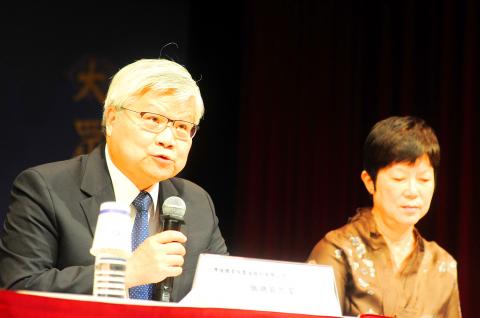Taiwan Semiconductor Manufacturing Co (TSMC, 台積電), the world’s largest contract chipmaker, yesterday said that it has fully recovered from a computer virus that struck the company on Friday evening last week.
Projected costs arising from the incident have been lowered to 2 percent of this quarter’s revenue, down from a previous forecast of 3 percent on Sunday, TSMC told a news conference at the Taiwan Stock Exchange in Taipei.
Gross margin would fall by 1 percentage point due to the cost of remedying the disruption to production, the company said.

Photo: Wang Yi-sung, Taipei Times
TSMC had previously forecast revenue of US$8.45 billion to US$8.55 billion for the third quarter, meaning losses would range from US$169 million to US$171 million, while gross margin is expected to be between 47 and 49 percent this quarter, down from its earlier guidance of 48 to 50 percent.
TSMC confirmed that the virus, which affected its fab tools, was a variant of the WannaCry ransomware worm.
TSMC said the incident occurred when new equipment was installed and connected to the company’s private network without first being scanned in an isolated system and cleared of viruses.
The WannaCry worm, which is known for its ability to spread rapidly, infected other fab tools at other plants via the company’s private network, TSMC said.
The advanced 7-nanometer fabs took the longest to recover from the virus, it said.
“The incident was caused entirely by a failure to follow protocol,” TSMC chief executive officer C.C. Wei (魏哲家) said, denying rumors it was a targeted cyberattack, the work of an internal agent or an act of sabotage via a USB drive.
Wei said the company has not received any ransom demands and none of its data were encrypted by the virus.
“We are in the process of revamping our security protocols, which would remove the possibility of such an error recurring,” Wei said, adding that the new system would be hardwired to block unverified nodes from connecting to the company’s private network.
“We do not expect these security upgrades to greatly affect operating expenses,” Wei said.
It is difficult to ensure that all of the company’s Windows 7 machines have been updated with the latest security patches, as the process requires collaboration with equipment suppliers and can only be performed during downtime, he said.
Wei declined to identify the fab tool that was initially affected, or its supplier, and whether TSMC would pursue legal recourse.
“We have installed tens of thousands of fab tools,” Wei said, adding that it is not normal for tools that have come straight out of the box to carry viruses.
“Our sole priority right now is to maintain clear communication with customers,” Wei said.
TSMC would not be exposed to breach of contract penalties from delayed shipments, chief financial officer Lora Ho (何麗梅) said.
Insurers only offer protection products for losses resulting from theft of customers’ personal data, a situation that does not apply to the TSMC incident, Ho said.
TSMC shares yesterday dipped 0.61 percent to NT$245.5 in Taipei trading.

CHIP RACE: Three years of overbroad export controls drove foreign competitors to pursue their own AI chips, and ‘cost US taxpayers billions of dollars,’ Nvidia said China has figured out the US strategy for allowing it to buy Nvidia Corp’s H200s and is rejecting the artificial intelligence (AI) chip in favor of domestically developed semiconductors, White House AI adviser David Sacks said, citing news reports. US President Donald Trump on Monday said that he would allow shipments of Nvidia’s H200 chips to China, part of an administration effort backed by Sacks to challenge Chinese tech champions such as Huawei Technologies Co (華為) by bringing US competition to their home market. On Friday, Sacks signaled that he was uncertain about whether that approach would work. “They’re rejecting our chips,” Sacks

NATIONAL SECURITY: Intel’s testing of ACM tools despite US government control ‘highlights egregious gaps in US technology protection policies,’ a former official said Chipmaker Intel Corp has tested chipmaking tools this year from a toolmaker with deep roots in China and two overseas units that were targeted by US sanctions, according to two sources with direct knowledge of the matter. Intel, which fended off calls for its CEO’s resignation from US President Donald Trump in August over his alleged ties to China, got the tools from ACM Research Inc, a Fremont, California-based producer of chipmaking equipment. Two of ACM’s units, based in Shanghai and South Korea, were among a number of firms barred last year from receiving US technology over claims they have

It is challenging to build infrastructure in much of Europe. Constrained budgets and polarized politics tend to undermine long-term projects, forcing officials to react to emergencies rather than plan for the future. Not in Austria. Today, the country is to officially open its Koralmbahn tunnel, the 5.9 billion euro (US$6.9 billion) centerpiece of a groundbreaking new railway that will eventually run from Poland’s Baltic coast to the Adriatic Sea, transforming travel within Austria and positioning the Alpine nation at the forefront of logistics in Europe. “It is Austria’s biggest socio-economic experiment in over a century,” said Eric Kirschner, an economist at Graz-based Joanneum

OPTION: Uber said it could provide higher pay for batch trips, if incentives for batching is not removed entirely, as the latter would force it to pass on the costs to consumers Uber Technologies Inc yesterday warned that proposed restrictions on batching orders and minimum wages could prompt a NT$20 delivery fee increase in Taiwan, as lower efficiency would drive up costs. Uber CEO Dara Khosrowshahi made the remarks yesterday during his visit to Taiwan. He is on a multileg trip to the region, which includes stops in South Korea and Japan. His visit coincided the release last month of the Ministry of Labor’s draft bill on the delivery sector, which aims to safeguard delivery workers’ rights and improve their welfare. The ministry set the minimum pay for local food delivery drivers at